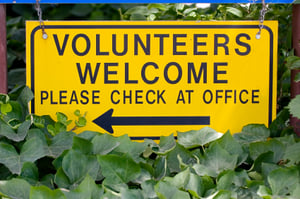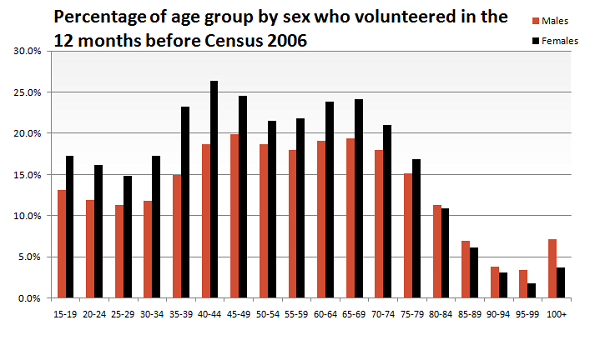The 2006 Census was the first to ask questions relating to unpaid work in Australia, particularly child care, assistance to people with a disability, and volunteering. The question on volunteering was fairly broad, just asking whether a person had volunteered for an organisation or group in the last 12 months, nothing about length or regularity of volunteering. But it can give us a bit of insight into a sector of the economy often forgotten but very important to local government. The 2011 Census will give us a time series on this.

In 2006, 17.9% of people counted in the Census indicated that they volunteered in the previous year. Volunteers were more likely to be female (57%), middle-aged and relatively high income. Charting percentage of volunteers by age group shows a double peak, with people in their 40s, and late 60s about equally as likely to volunteer, but less people in their 50s. This double peak is far more visible among women than men, which indicates that it may well be women with family responsibilities not in the paid workforce who make up the peak in their 40s perhaps including volunteering for schools. The assumption of those aged 65+ is that they are retirees volunteering, so it’s less clear why there would be a peak among women here. However women were more likely than men to volunteer in all age groups, until 80+. After this age, the rate of volunteering drops right off, and there are more women around, due to men’s shorter life expectancy. As a man, if you’re still around at that age, you’re more likely to be a volunteer!

One of the most interesting patterns in volunteering is the effect of income. When you look at the individual incomes of people doing the volunteering, there is no strong correlation with any income level, both high and low income people are almost equally likely to volunteer. However when you look at household income, especially when equivalised (to adjust for household size and composition), there is a strong correlation, the higher the income of your household, the more likely you are to volunteer. So it seems that people tend to do voluntary work only when their household income is secure. Those low income individuals who volunteer are more likely to have a high income partner.

The interesting exception is “Negative Income”, which appears at the bottom end of the income scale. Households which state negative income tend to share a lot of characteristics with high income households, far more than they share with nil or low income households. Not only do they have higher rates of volunteering, but they have higher education levels, are more likely to own their homes than be renting etc. The rate of volunteering among those with negative incomes is about the same as those on top quartile incomes. The assumption is of course that the negative income is due to business expenses and tax write-offs rather than any real income deficiency in this group.
Another factor which has been mentioned by other commentators is the strong difference between Australian-born, English speaking populations, and those of migrant backgrounds. Volunteering on the Census shows that those born here and speaking English are more likely to volunteer. In 2006, 21% of people speaking English at home had volunteered, and only 11% of non-English speakers. This could be because of language difficulties, but also perhaps from a cultural difference in an understanding of what volunteering is, with those born here perhaps more likely to volunteer in a formal capacity, while the question doesn’t ask about informal volunteering within the community which might be more prevalent among recent migrants.
Finally, a look at the breakdown by state. By a large margin, the ACT (22.3%) had the highest percentage of volunteers, probably related to the higher incomes and public sector jobs (which may be more accommodating of “extra-curricular” activities). South Australia was not far behind, but Western Australia had the lowest percentage, at 16.8%. I suspect this is due to the labour shortage and high number of hours worked in paid employment there. The difference between the highest and lowest percentage by state was fairly small, though.

The 2011 Census form will contain the same questions as 2006, so this will give us an opportunity to look at time series for the new questions which were asked in 2006, including volunteering, internet connection, disability etc. We’ll be able to track how rates of volunteering and other unpaid work have varied over a 5 year period, a time which included the Global Financial Crisis, and unprecedented population growth.
To find out about volunteering statistics in your local government area, go to your online community profile – for example The City of Bankstown Community Profile. To find volunteering statistics for other LGAs across Australia, access their online community profiles via .id’s Demographic Resource Centre.
.id is a team of demographers, population forecasters, spatial planners, urban economists, IT and data experts who use a unique combination of information, applications and consulting to help governments and organisations understand people and places for evidence-based planning.
Access our free demographic resources here.













